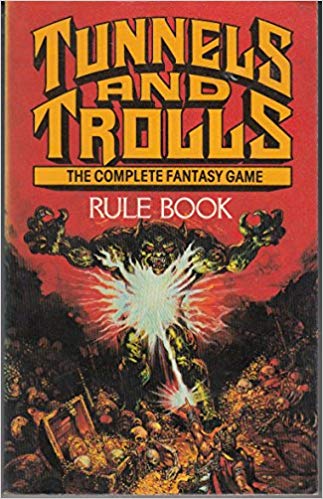I started to feel that I didn’t know roleplaying games well enough so I came up with the plan to read a roleplaying game corebook for every year they have been published. Selection criteria is whatever I find interesting.

So far, every game I’ve written about has been a first edition. Indeed, in a young field, that’s tended to be the only option available. Now in 1986 there’s enough roleplaying history to pick a new version of an old game, in this case the British Corgi mass market paperback version of the 5th edition of the classic American game Tunnels and Trolls.
Finding copies of the games to read for this project has been difficult at times, so I admit one key reason for this choice was that I had the book sitting on my shelf.
Tunnels and Trolls is a light-weight dungeon crawl roleplaying game, like D&D except less serious. It’s famous for spell names such as “Take that, you fiend!”. The basic game provides rules for character creation and combat, as well as some Game Master tools for making dungeons.
In terms of mechanics, one unusual idea is that each side in a combat adds together the results of each character’s actions into point totals which are then compared. So player characters could get 56 and the monsters 45. The difference between these numbers is used to figure out who won that round, and how much damage must be distributed among combatants.
The standout feature of the Tunnels and Trolls book has nothing to do with the mechanics, however. It’s about the tone. The book has been written in a conversational, informal style that permeates everything right down to specific game mechanics.
Many roleplaying games suggest that the players customize the game to their needs, but Tunnels and Trolls really embraces this, practically forcing the reader to adapt the rules. A combat mechanic might be explained in three different ways, with the suggestion that the reader pick a favorite. Or there’s a note saying that an earlier edition, a specific rule was different, giving the possibility to revert back to it.
The text in Tunnels and Trolls reads less like a rulebook and more a documentation effort capturing what the play community was doing. It even makes references to the “Phoenix players”, who I assume to be the designer’s home community. The book explains how this or that GM in Phoenix used a rule.
This reaches it’s peak in the chapter on expanding the world. Tunnels and Trolls is assumed to happen in a series of dungeons with little to connect them, but the game also gives the option of creating your own fantasy setting. There’s an explanation how some folks in Phoenix did this: “When the question of a continent to put these places came up, Bear drew the dragon-shaped continent of Rhalph, almost as big as all Eurasia.”
This writing style makes the book hard to understand, but it’s also refreshing compared to the way most roleplaying game books are written.
One thought on “A Game Per Year: Tunnels and Trolls (1986)”
Comments are closed.